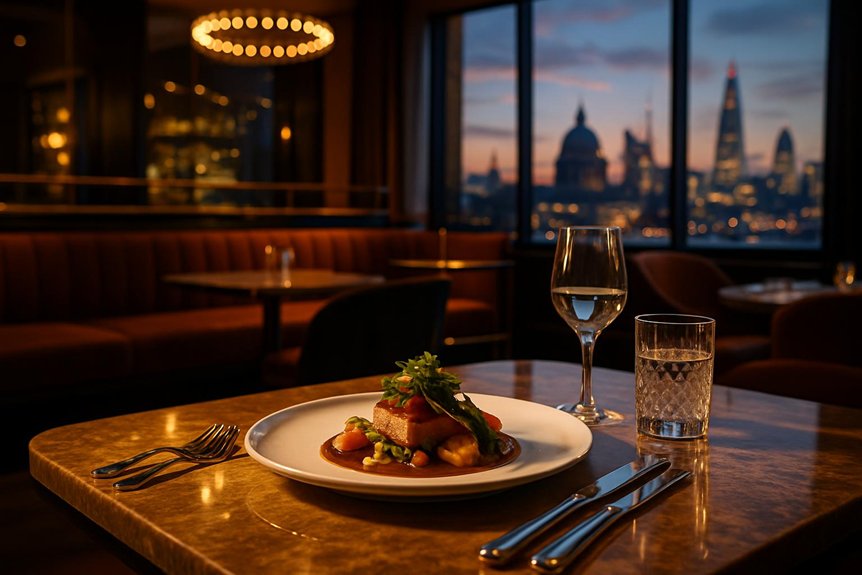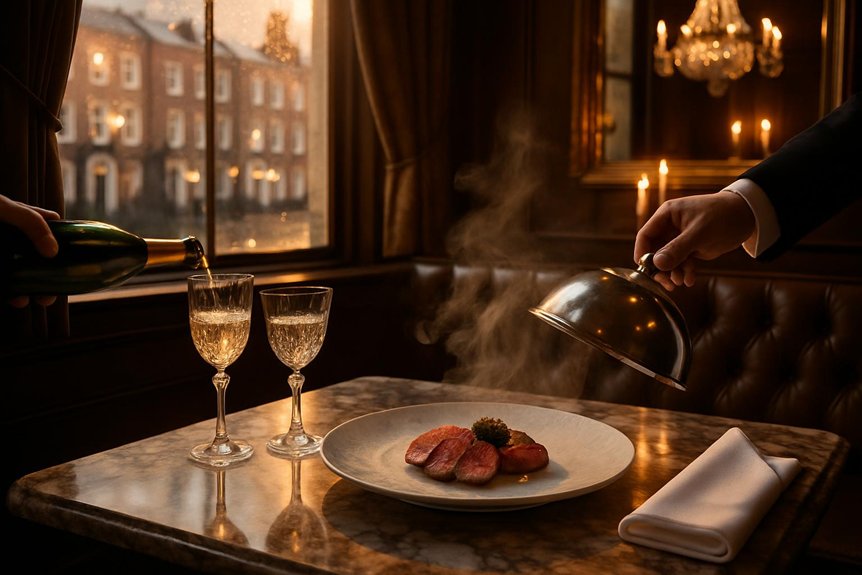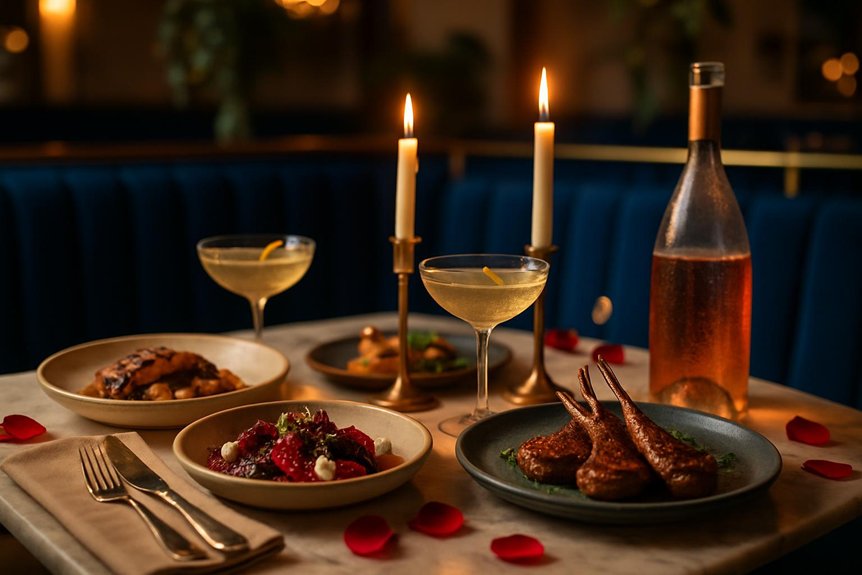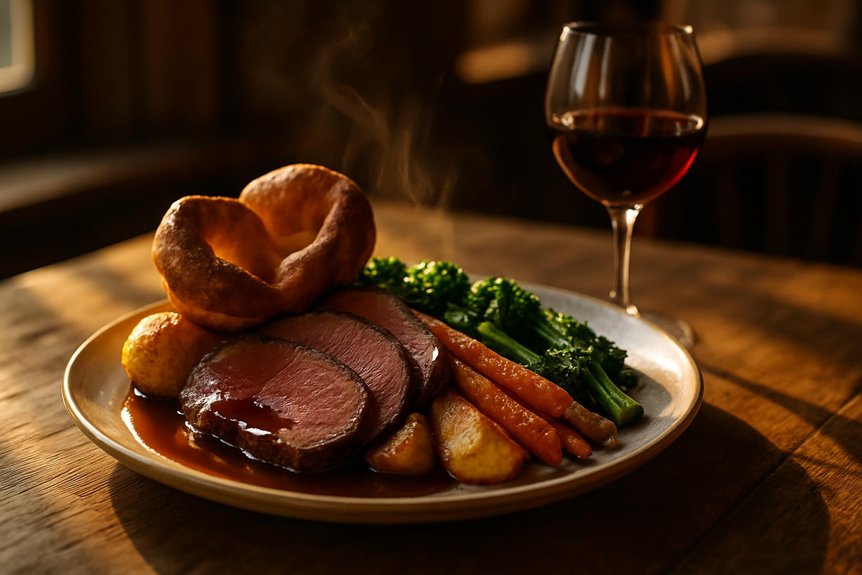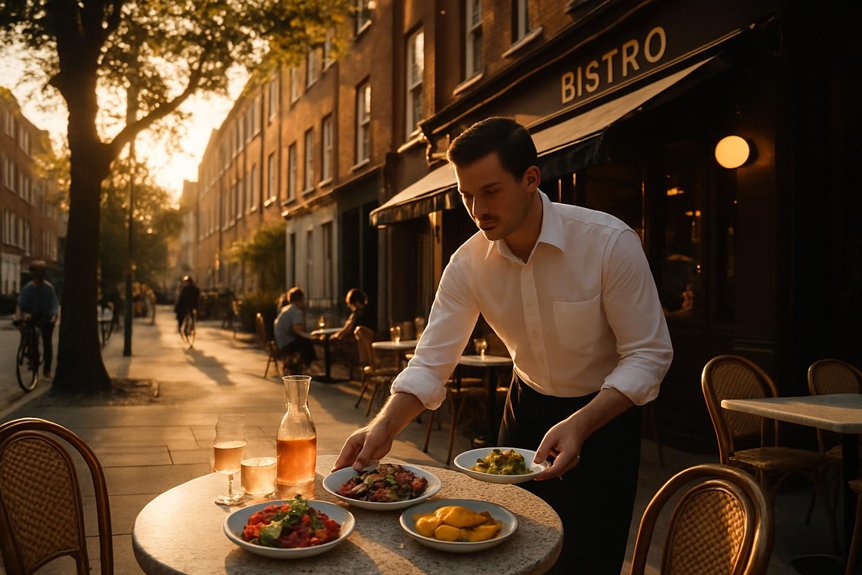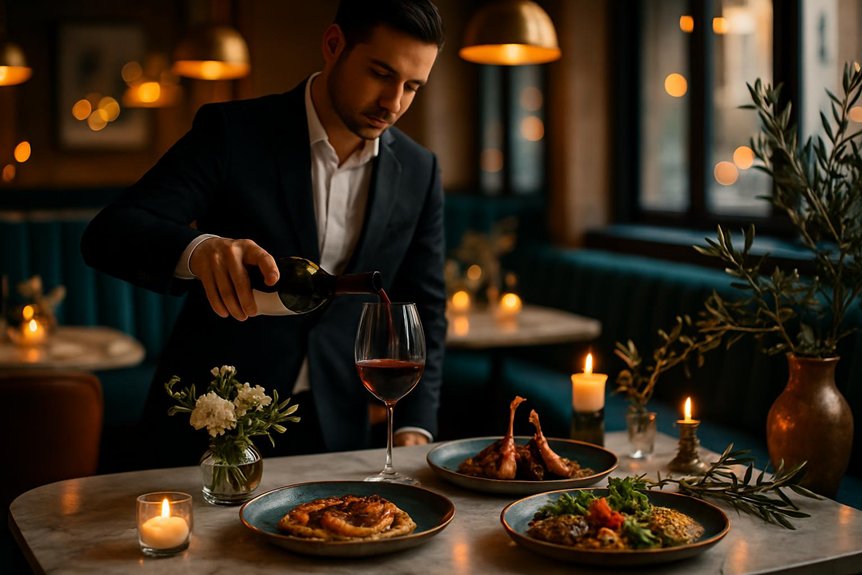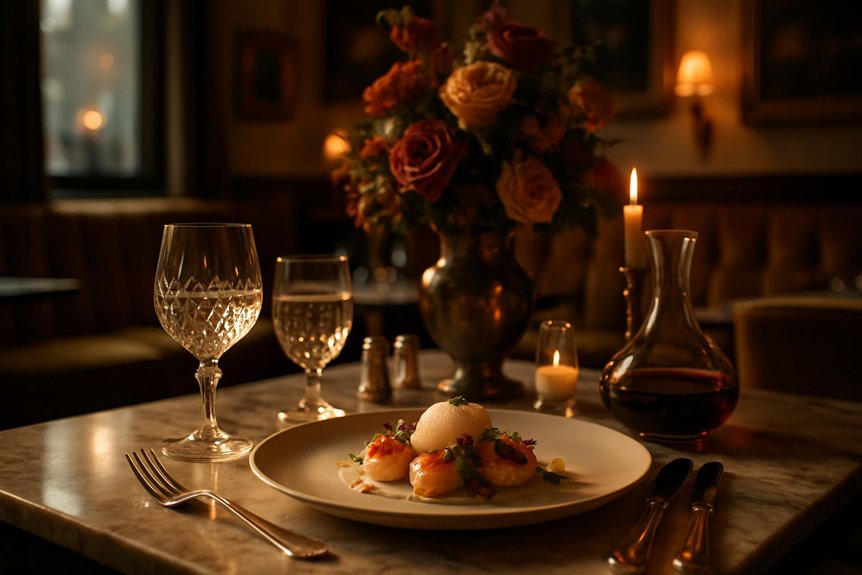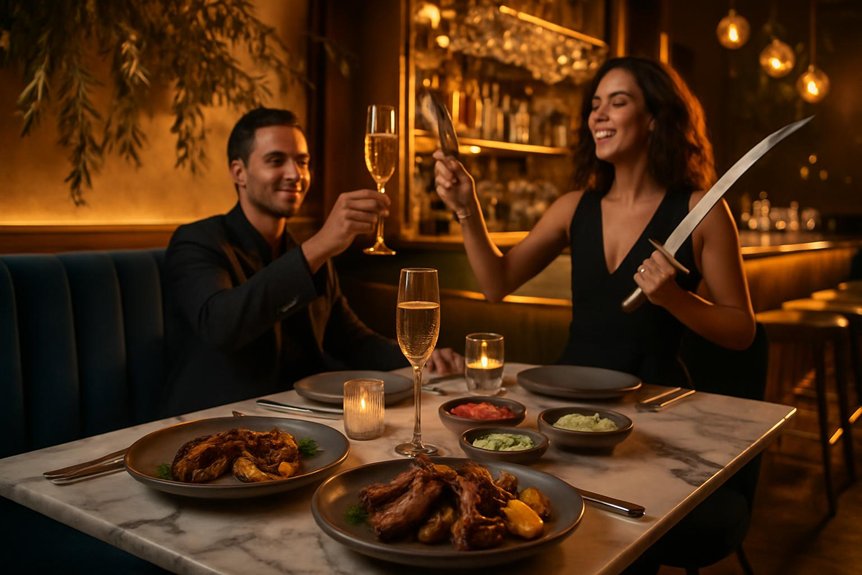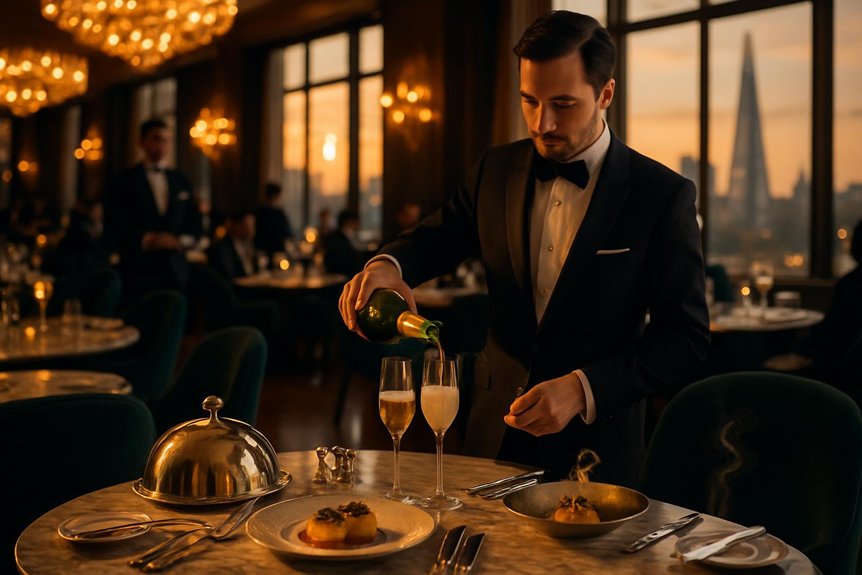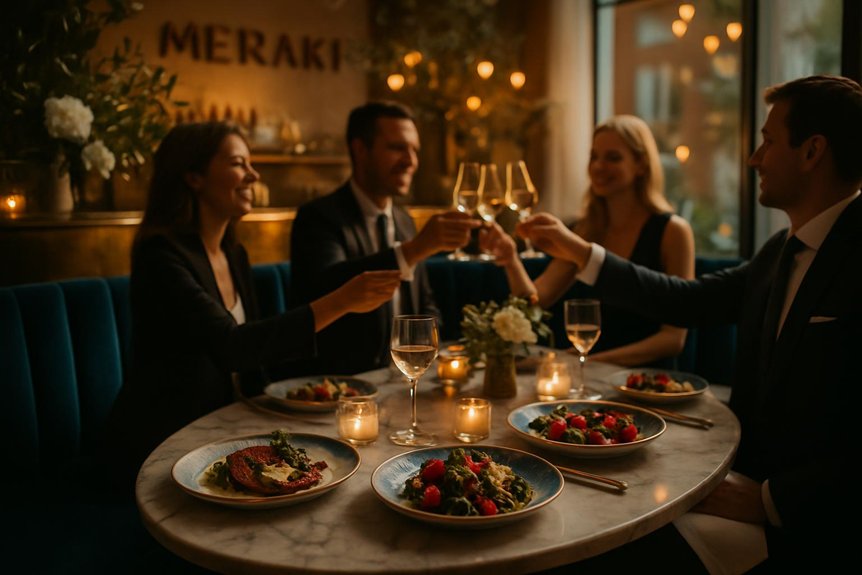London’s luxury restaurants balance inherited grandeur with contemporary creativity. High-ceilinged dining rooms and discreet white-glove service sit alongside experimental tasting menus and molecular techniques. Patrons encounter carefully sourced produce, precise plating, and a quiet theatricality that rewards attention. The city’s riverfront terraces and intimate chef’s tables add varied atmospheres, hinting at traditions reworked and surprises to come.
Historic Dining Rooms With White-Glove Service
Although rooted in tradition, London’s historic dining rooms project a quiet authority: high-ceilinged rooms, polished silver, and staff trained to anticipate needs create an atmosphere where service itself is a central craft. Patrons move through spaces that preserve period details—wood panelling, crystal chandeliers, and art deco interiors—while discreetly updated lighting and climate control ensure comfort.
Tables are arranged to respect privacy and ceremony, each place setting completed with vintage silverware that signals continuity and care. Menus favor time-honoured techniques and seasonal sourcing, presented with methodical pacing. Servers execute rituals—silver cloche lifts, precise pourings—that foreground hospitality skills.
The resulting experience privileges restraint and refinement, appealing to diners who value ceremony over spectacle in a city of evolving tastes. Meraki Bar, a hidden living room bar beneath Meraki Restaurant, exemplifies this blend of classic elegance and modern flair with its vibrant atmosphere and innovative menu offerings.
Modern Tasting Menus and Experimental Cuisine
How do London’s top tables translate curiosity into courses? Chefs craft modern tasting menus that prioritize discovery, pairing seasonal produce with molecular gastronomy techniques and subtle flavor infusions.
Service guides diners through calibrated progressions where texture, aroma, and temperature shift deliberately. The city’s experimental cuisine balances risk and refinement, offering compact narratives in eight to twelve courses that reveal provenance and technique without theatrical excess.
Reservations often note dietary preferences so menus adapt while preserving conceptual integrity. Smaller plates encourage shared attention, and pacing respects conversation as much as taste.
Presentation remains restrained, emphasizing taste architecture over spectacle, so each bite advances an overarching theme and leaves a clear impression of innovation grounded in culinary discipline.
- Layered tastes that tell a story
- Precision through technique
- Sensory restraint, maximized impact
Meraki, located near Oxford Circus, exemplifies this approach with its open kitchen and award-winning food, curated by celebrity chef Athinagoras Kostakos.
Michelin-Starred Establishments Worth the Splurge
What makes a Michelin-starred meal in London worth the splurge is the combination of exacting technique, rare ingredients, and a service choreography that elevates time at table into a memorable event. Reviewers note how chefs blend farm to table sourcing with contemporary presentation, turning provenance into palpable flavor.
Kitchens prioritize culinary innovation while respecting classical foundations, producing tasting sequences that reveal discipline and imagination. Service remains unobtrusive yet meticulous, guiding pacing and wine pairings so each course resonates.
Ambience is restrained luxury rather than ostentation, allowing food to command attention. For diners seeking a definitive gastronomic statement, these establishments justify premium prices through unmatched skill, ingredient quality, and an overall orchestration that transforms dining into a curated experience. A restaurant like Meraki, known for its vibrant flavours and intricate textures, exemplifies how ambiance and culinary excellence combine to create an extraordinary dining experience.
Riverfront and Rooftop Culinary Destinations
Attention turns next to riverfront and rooftop culinary destinations, where panoramic Thames vistas and skyline bars shape the dining experience. Chefs and mixologists alike tailor menus to complement the changing light and cityscape.
These venues balance striking views with refined cuisine and inventive cocktails.
Scenic Thames Dining
When evening light gilds the river and the city’s silhouette sharpens, London’s Thames-side and rooftop restaurants offer a blend of panoramic views and refined cuisine that defines scenic dining in the capital. The scene combines seasonal menus highlighting seafood delicacies with curated wine lists, terraces and garden patios that temper urban energy.
Service emphasizes timing: courses paced to coincide with sunset, plates composed to mirror the view. Interiors balance intimacy and openness so conversation and sightlines coexist. Attention to local sourcing and sustainable practice anchors luxury in responsibility.
Reservations are strategic; peak windows command planning. Such venues transform a meal into an occasion where riverine calm, culinary craft, and architectural drama converge.
- Seasonal menus reflecting the Thames
- Intimate layouts with expansive views
- Sustainable sourcing and local produce
Skyline Rooftop Bars
A skyline rooftop bar casts London’s panorama into the role of co-host, where curated cocktails, small plates, and layered lighting frame views of the river, bridges, and historic spires. Patrons move between intimate lounges and open terraces, selecting tasting flights or sharing plates that balance playful textures with seasonal produce.
Service blends theatricality and restraint: bartenders craft signature mixes as discreet staff deliver plates timed to sunset. Some venues pair elevated menus with culinary workshops by visiting chefs, turning evenings into hands-on lessons that demystify technique while preserving ambiance.
Dessert offerings often mirror the menu’s refinement, and “just desserts” appear as composed miniatures rather than cloying finales. The scene rewards conversation, perspective, and careful design.
Classic British Fare Reimagined With Contemporary Techniques
Chefs in London’s fine dining rooms resurrect heritage ingredients such as beef dripping, heirloom vegetables, and wild game. They pair these with modern techniques like sous-vide, smoking, and molecular sauces. These kitchens rework traditional plates into focused seasonal British tasting menus that highlight provenance and texture.
The result is a restrained conversation between memory and innovation that reframes national classics for contemporary palates.
Heritage Ingredients, New Methods
London’s dining ateliers are coaxing century-old British ingredients into new shapes and textures, pairing marrow, nettles, and salt-cured cod with modern techniques such as sous-vide, fermentation, and smoke infusion.
The kitchens foreground sustainable sourcing and artisanal techniques, transforming humble staples into composed courses that respect provenance while testing texture and acidity.
Chefs extract umami from bone, elevate weeds to garnish, and reinterpret preserves as acid-balanced gels, all within rigorous plating languages.
The result is restrained innovation: familiar flavors reframed, not erased.
- Tradition as laboratory: heritage ingredients examined for latent potential.
- Technique as translator: contemporary methods reveal new flavor narratives.
- Responsibility as principle: sourcing and craft define culinary legitimacy.
Seasonal British Tasting
Moving from ingredient-led experimentation to full-course narratives, the Seasonal British Tasting frames classic dishes—steak and kidney, kedgeree, spotted dick—through a contemporary lens that privileges seasonality and technique.
Chefs sequence courses to trace the year: spring asparagus and nettles, summer chalkstream trout, autumn game, winter root vegetables, each plate reduced to essential flavors. Modern methods—low-temperature cooking, clarified broths, smoke and fermentation—recast familiar textures while preserving comforting profiles.
Service emphasizes tasting traditions: measured pours, palate cleansers, and verbal storytelling that situates ingredients in place and time. The result is restrained theatre, where provenance and precision supplant ornament.
Diners encounter heritage recipes rebuilt for immediacy, a quietly confident fusion of memory, science, and the seasonal british table.
Intimate Chef’s Table and Private Dining Experiences
A discreet chef’s table offers rare access to the kitchen’s choreography, where a small number of guests observe ingredient selection, plating and the cadence of service while enjoying a tailored multi-course menu. The setting emphasizes culinary intimacy, with chefs narrating technique and presenting courses personally.
Private dining rooms complement this, providing refined seclusion for celebrations or focused business meals; staff coordinate timing and atmosphere to bespoke specifications. Demand requires exclusive reservations, often booked weeks ahead, ensuring service precision and menu customization.
Such experiences highlight provenance, texture contrasts, and moment-to-moment dialogue between cook and diner without overpowering formality.
- Direct interaction with the creative team
- Curated menus responding to guest preferences
- Controlled environment for privacy and pacing
Wine Pairings, Cocktail Programs, and Beverage Excellence
Three pillars—thoughtful wine pairings, inventive cocktail programs, and meticulous non-alcoholic offerings—define beverage excellence in the city’s top restaurants. Sommeliers curate lists that balance Old and New World vintages, matching acidity, tannin and aromatics to seasonal tasting menus.
Mixologists develop craft cocktails that complement texture and spice, often incorporating house-made syrups, bitters and local botanicals. Beer programs expand beyond mainstream labels to include carefully selected craft beer that pairs with heartier courses or adventurous flavor profiles.
Non-alcoholic options receive equal attention: complex mocktails, premium teas and artisanal soft drinks provide structure and balance. Service practices—timely pours, explanatory tasting notes and seamless coordination with kitchen timing—ensure each beverage elevates the dining narrative.
Conclusion
London’s luxury restaurants weave historic splendor and cutting-edge technique into a singular dining tapestry, where white-glove rituals meet sous-vide precision and molecular flourishes. Guests drift from chandeliered dining rooms to rooftop terraces and riverfront tables, sampling reimagined British classics, daring tasting menus, and impeccable wine and cocktail programs. Intimate chef’s tables and private salons guarantee each visit feels bespoke—an elegant promenade with a hint of Victorian curiosity and a futurist’s palate, like dinner with a gentleman from 1895.
